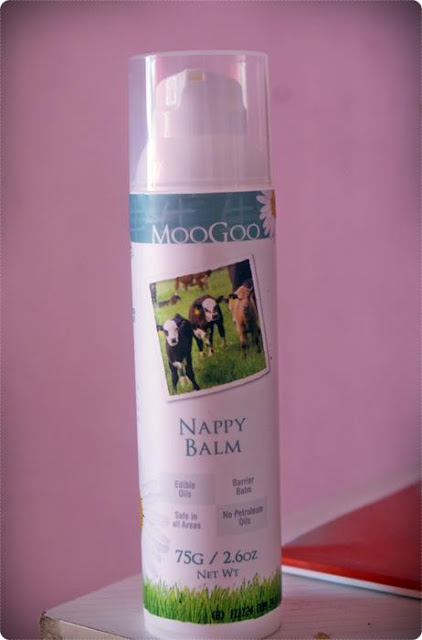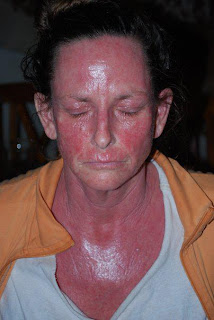MooGoo Nappy Balm - Healing Infections with Zinc Oxide
One of the many challenges of topical steroid withdrawal in eczema sufferers is secondary infection. Somehow the excessive itching or even severe dryness that cause cracking of skin has created lesions and ulcers. Most infected sights will typically look like these few photos below
It is noticed that there is reduced lipid (oily) layer of the skin of eczema sufferers when compared to other people. Lipid barrier aids in preventing excessive loss of moisture and when this is reduced it simply means water is lost more rapidly making the skin drier, bringing on chronic itching. Other than that, sweating and high changes of temperature can cause an eczema skin to get worst.
Extreme dryness,plastic feeling skin and insane itching is also a much common condition in Topical Steroid Withdrawal. The reason for this is because many forget that topical steroids too can cause a secondary eczema on top of the one you already have. There are many names of this condition (steroid eczema) but most commonly known as steroid induced rosacea.
The exacerbating of the skin that undergoes constant scratching and becomes opened wound infection believed to be caused by Staphylococcus aureus. Staphylococcus aureus is a bacterium that is a member of the Firmicutes, and is frequently found in the human respiratory tract and on the skin. damage to the skin or other injury may allow the bacteria to overcome the natural protective mechanisms of the body, leading to infection.
Staphylococcal disease of the skin usually results in a localized collection of pus, known as an abscess, boil, or furuncle, depending upon the exact type of lesion that is present. The affected area may be red, swollen, and painful. Drainage or pus is common. When Staph is in the blood (bacteremia or sepsis), it can cause high fevers, chills, and low blood pressure.
In both cases we had recommended zinc oxide. It seems that from our reading, Topical creams containing zinc oxide are helpful for atopic eczema as well as wound healing. Many skin conditions are related to zinc imbalances. These include acne, psoriasis, eczema, vitiligo and other cases of dermatitis. Zinc do help with wound healing, and helps give collagen and other tissues their elastic quality. Zinc oxide ointment is a folk remedy for skin disorders.
This was also noted in the study "Studies on zinc in wound healing." Agren MS. Acta Derm Venereol Suppl (Stockh). 1990; 154:1-36.
The inflammatory reaction was diminished in zinc treated wounds except when a high zinc sulfate concentration was applied
The anti-bacterial mechanism of zinc oxide seemed to be more indirect and to be mediated via local defense systems rather than being directly toxic to the bacteria
When zinc is applied on wounds it not only corrects a local zinc deficit but also acts pharmacologically
Zinc does have a major role in wound healing. It has excellent anti-inflammatory and drying properties which means that bacteria has less grounds to bread on. Normally, it is also required in a variety of enzymatic and cellular activities, but becomes increased in demand during the wound healing process. By providing zinc ions to the wound, these type of creams appear to enhance the wound healing process and allow them to remain there for an extended time. In addition, Zinc oxide are also helpful in blocking irritants from in contact with skin, minimizing infection and promoting healing.
We have also advised our members to consume Probiotics to enhance their immune system to ward of the infection (probiotics helps to provide a much more balanced gut flora), to eat less complex carbs and low sugar diets during healing (since immune cells do not work efficiently when blood sugar levels are high) and to eat high anti oxidant foods from fruits and vegetables. Most members are already taking Olivenol Plus which contains a substance called Hydroxytyrosol that not only helps to promote the healing of wounds and skin conditions but has anti-inflammatory properties
Here are the results after using zinc oxide creams:
We would not think this would be the first time we had asked our group members to use the MooGoo Nappy Balm to help with these conditions. It has really worked in the past, but we never pin pointed or dig deeper into the science. Now that we have, we are extremely lucky that such natural and chemical free product is available at our expense. Our members continued to use the Nappy Balm for a few days (2-3) until wounds were no longer weepy and looked dry, then continues to use the MSM Soothing Cream that contains organic sulfur called Methyl-Sulfonyl-Methane. Sulfur is needed for the proper synthesis of collagen. Collagen is what helps skin goes back to its original form. We have also noted that some dermatologist have actually suggested the use of zinc oxide ointment and that the patient found the cream in the "diaper cream section". Well this does not come to our suprise :)
Caution :
Please ensure that you are not allergic to Zinc Oxide before trying this method.
MooGoo Nappy Balm can be purchase at this website
http://www.moogoo.my/specialty-creams/nappy-balm.html
References :
http://www.patient.co.uk/doctor/Atopic-Dermatitis-and-Eczema.htm http://www.earthclinic.com/CURES/eczema6.html#GACVZO http://healthyliving.msn.com/diseases/diabetes/high-blood-sugar-and-slow-healing-wounds-1
http://www.livestrong.com/article/134121-the-effect-zinc-oxide-skin/
http://www.medicinenet.com/staph_infection/page2.htm
http://itsan.org/forum-and-faqs.html
http://www.google.com/patents/US20100331377
http://www.olivenolplus.com/news.shtm








Comments
Post a Comment